
|
Menu |



|
Menu |


Universe, galaxies, stars

| For more photos, simply follow Marsty. | |
| For more detailed information, simply follow Cosmo. |
How the universe came into being

You live on a small blue planet called Earth, which is part of our solar system. It is itself located in a galaxy called the Milky Way, a very small galaxy in the vast universe.
Your challenge for this adventure is to unlock the secrets of the universe. Are you ready? We wish you a pleasant journey through the cosmos!

Discover the universe with Marsty ! (© Arteclick).
 What is the universe ?
What is the universe ?The universe encompasses all that exists: atoms, planets, stars, galaxies and clusters of galaxies, but also the immense void of space, energy, light and even time itself !
The universe is very dynamic. All the time galaxies are colliding, stars are being born and dying, planets and atoms are forming… and that’s only part of the story ! Even today the Universe continues to grow. It is expanding.

The expanding Universe, galaxies are moving away from each like dots on the surface of an inflating balloon(© Arteclick).
 How did the universe originate ?
How did the universe originate ?This remains a big mystery!
Mathematical calculations and observations using telescopes and satellites exploring the universe have allowed scientists to develop a plausible scenario to explain how our universe was born and developed.
That scenario is the Big Bang model.
To date, scientists still do not know if anything existed BEFORE the Big Bang. However, thanks to the Big Bang model, they understand a lot of what happened AFTERWARDS and are able to tell us a lot about this fantastic story.
13.8 billion years ago, the universe was the size of a minuscule speck of dust. It was extremely hot and dense. Now, imagine an instant much, much shorter than the blink of an eye. Imagine at that place and time, light and energy were inseparable from each other as well as being invisible!
Somehow or other, the universe was suddenly shaken by a Big Bang, which transformed energy into matter. This process marked the start of the universe’s growth, and as it expanded, its temperature fell, just as it is still falling today.
In the very first instants of its existence, the universe abruptly expanded and cooled down, enabling time, space, energy and fundamental forces of nature to exist.
At this stage, the universe was a kind of dense, extremely hot soup made up of particles of light, matter and dark matter.
The smallest particles of matter are quarks, electrons, neutrinos, photons, bosons and gluons.
All matter is composed of these elements. In addition there is what scientists call dark matter.
Dark Matter contains heavy particles called “WIMPS” which only interact weakly with normal matter. At the moment dark matter is poorly understood and much research is ongoing to understand what it represents in the Universe
To understand this incredible event, scroll through this diagram for a step-by-step explanation of how the universe formed





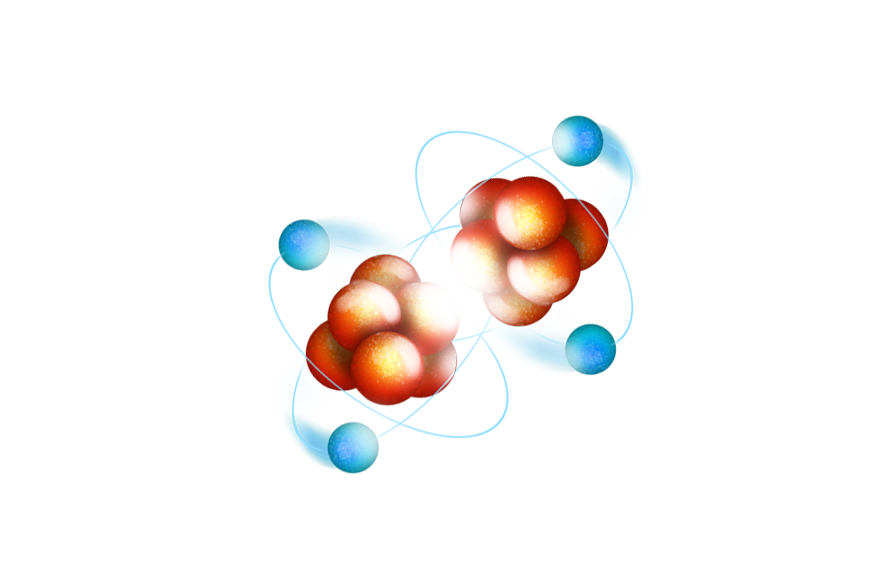



Quiz!
 Validate your knowledge!
Validate your knowledge!
How galaxies are formed

 A brief history of the cosmic microwave background
A brief history of the cosmic microwave backgroundAs early as 1948, three mathematicians (George Gamow, Ralph Alpher and Robert Herman) postulated that if a Big Bang had occurred, photons from it should still be radiating through the cosmos.
In 1965, the Big Bang model was validated by a discovery made by two engineers. Arno Penzias and Robert Woodrow Wilson were actually trying to build a radio antenna when they realised that their signal was constantly being disrupted by a noise originating from everywhere in space.
Very quickly, this noise was proved to be the radiation that the mathematicians had predicted ! We now call this noise the cosmic microwave background (or CMB for short) and know that it stems from regions of the cosmos that are currently more than 45 billion light years from Earth and with temperatures of roughly -271 degrees. However, when the radiation was emitted almost 13.8 billion years ago, the temperatures in those same regions were in the thousands of degrees.
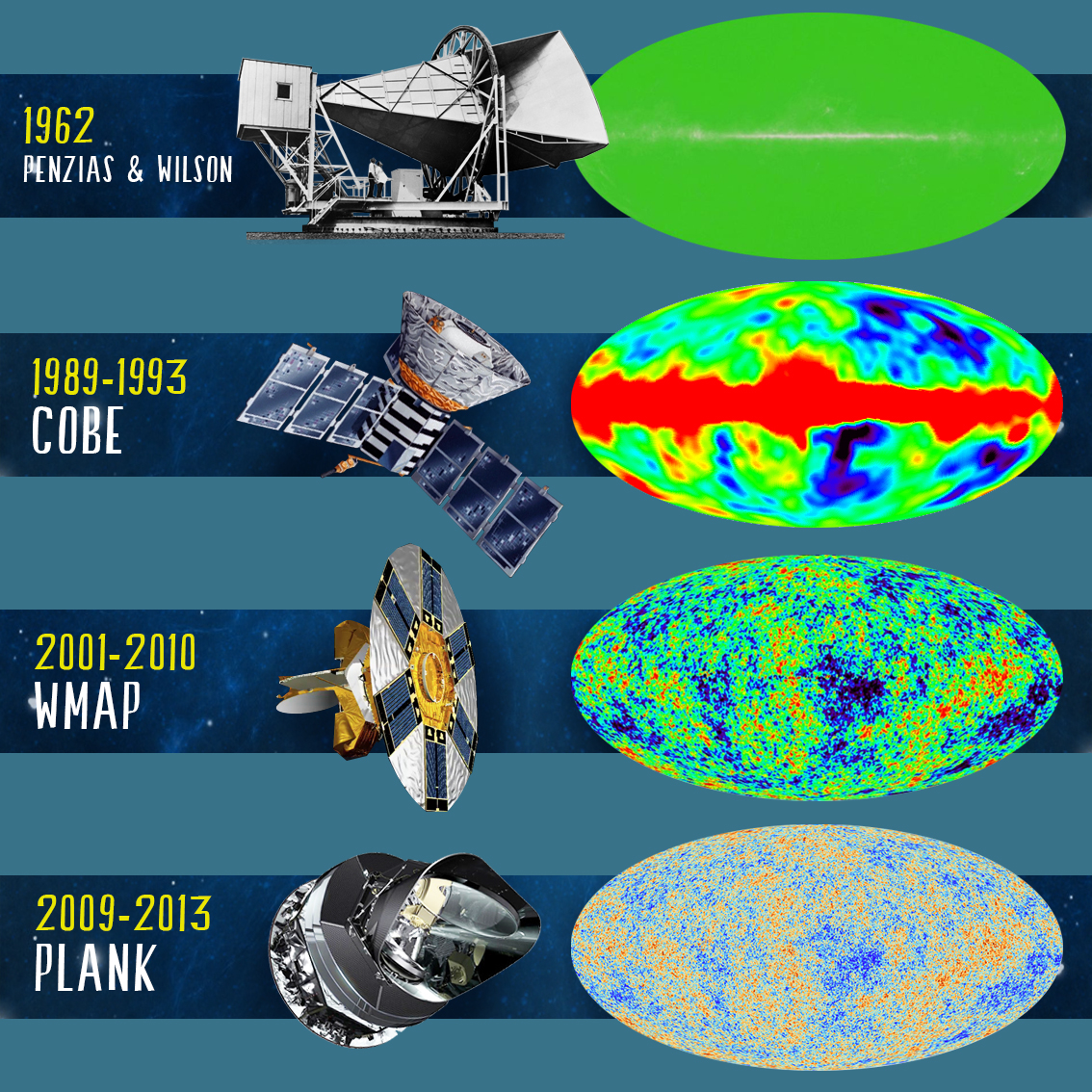
Discovery of cosmic microwave radiation. As technology evolves each new satellite sends more and more accurate images of this radiation. © Arteclick
This discovery was crucial because the CMB contains some extremely valuable information that is of fundamental importance to the study of cosmology.
The COBE, WMAP and Planck satellites were sent into space to get as close as possible to the CMB’s radiation. As technology advanced, each of these satellites sent back increasingly accurate images of it. Scientists were very surprised to discover that the universe’s structure is lumpy. Why aren’t these lumps all the same colour? Why aren’t they all the same size? Where do they come from? How did they form?
Studying these images has now made it possible to produce a kind of ‘identity card for the universe’, telling us its age, composition, history and development over time. This all helps us to understand how major structures like galaxies and stars form.
Before you move on to learning about stars, scroll through this diagram for a step-by-step explanation of how galaxies form!




 What you need to remember about your intergalactic voyage
What you need to remember about your intergalactic voyageAstronomers classify the 200 billion galaxies that have been observed so far on the basis of their shapes and how they have changed over time. The categories they distinguish are: spiral galaxies, elliptical galaxies and irregular galaxies.
Each of these types of galaxy has its own defining characteristics. Furthermore, over time galaxies change their shape and thus switch from one category to another. For instance, dwarf galaxies can merge to form irregular galaxies. These, in turn, can merge to form spiral galaxies, which may subsequently merge to form elliptical galaxies.
So generally speaking, the older a galaxy becomes, the more likely it is to be elliptical in shape.
Of the galaxies observed in the universe at present, 20% are elliptical, 77% are spiral and 3% are irregular.
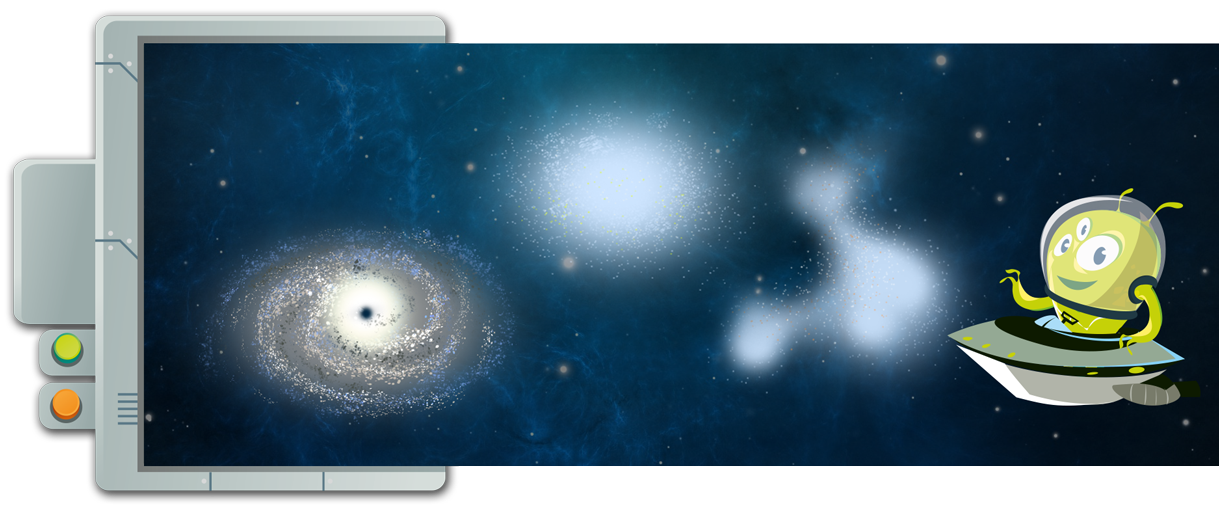
Spiral galaxiesSpiral galaxies are shaped like flattened discs with several bright arms coiled into a spiral shape. They measure between 30000 and 150000 light years across and have a black hole at their centre. They contain between 10 and 100 billion stars, plus dust and gas, and produce between 1 and 1,000 stars a year. Our galaxy is called the Milky Way, which is home to the solar system. |
Elliptical galaxiesElliptical galaxies contain between 10 million and 1000 billion old red and yellow stars. They are shaped like elongated balls and measure between 3000 and 600000 light years across. They contain very little gas and dust, which prevents them from creating new stars. They are old galaxies. |
Irregular galaxiesIrregular galaxies have no particular shape and measure between 3000 and 30000 light years across. They are very rich in helium gas, water, ammonia, methanol and silicate and carbon dust. They produce very large numbers of young stars. They are usually small and are referred to as dwarf galaxies. |
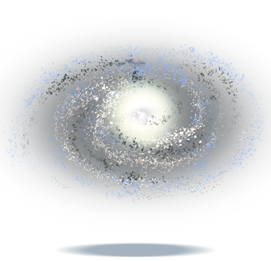
|

|

|
Quiz!
 Validate your knowledge!
Validate your knowledge!
How stars form

 The formation and subsequent development of stars
The formation and subsequent development of starsIn the photo below, you can see a huge cloud of gas in which stars are forming. This is a stellar nursery. Our galaxy includes this small portion of the Orion Nebula. It is one of the places in the Milky Way where millions of stars, like our sun, are born, grow, change shape and die.
So why do stars shine? And why do some only shine a little, while others shine very brightly?
As you learned before, nebulae are gigantic clouds of hydrogen and helium gas that formed at the time of the Big Bang. After they formed, the universe’s expansion caused its temperature to drop to around -271 degrees. This is too cold to give atoms the energy they need to fuse, so a nebula consists of around 90% hydrogen and 10% helium, existing side by side.
Violent winds make nebulae break up into a number of small clouds. Compressed by the force of gravity, each small cloud becomes far denser and hotter, causing it to assume the shape of a flat disc. When the gas at the centre of the disc reaches a temperature of around 2 million degrees, the hydrogen atoms there break down, releasing their proton. From this moment on, the protons gain sufficient to enable them to fuse and form new helium nuclei.
This thermonuclear reaction, which converts hydrogen into helium, generates enough heat to make stars shine.
A protostar is born!.
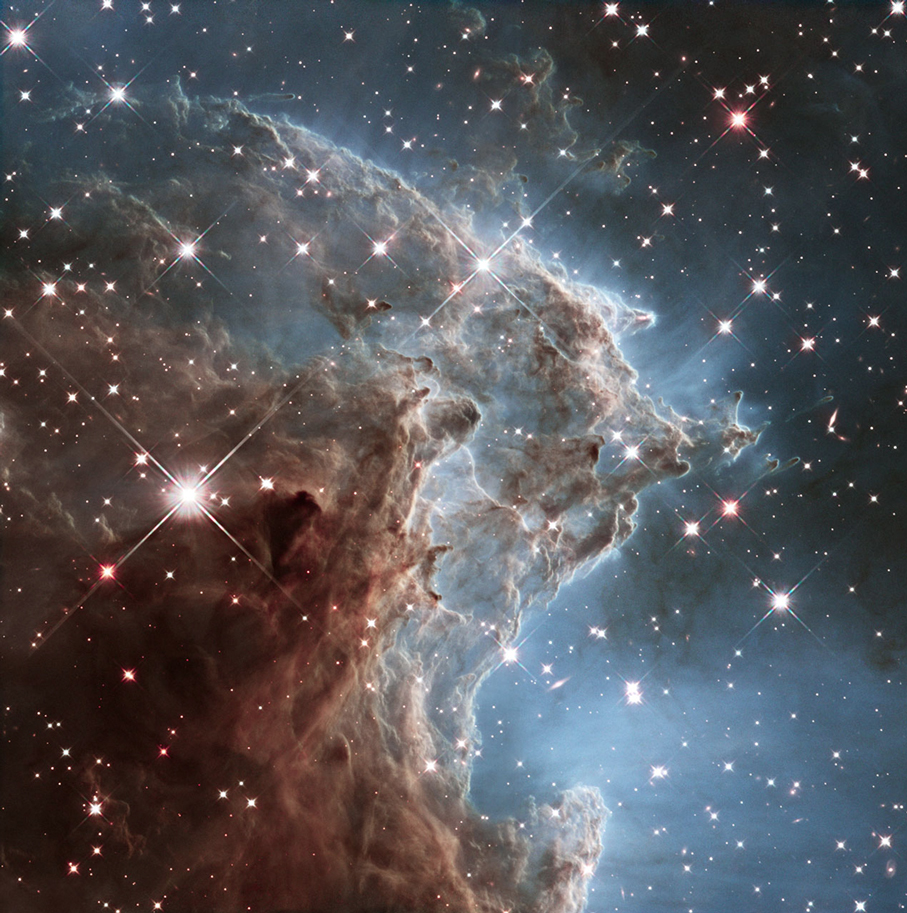
A small portion of the Orion Nebula in the Milky Way. © NASA, ESA, and the Hubble Heritage Team (STScI/AURA)
The thermonuclear reactions that convert hydrogen into helium release huge amounts of energy and generate unbelievable pressure within the protostar, which can now withstand the pull of gravity, creating a balance between that force and pressure.
A star is born!
So why are some stars hotter and brighter than others?
The answer is simple: because they are more massive!
In other words, the larger the original cloud that contracts under the effect of gravity, the more hydrogen atoms it will contain that can be converted into helium, making the resulting star hotter and brighter.
The hotter the star is, the more light it emits and the brighter it shines.
So it is the mass of a star that will determine its lifespan and fate, i.e. what becomes of it!.
To understand how stars change over time, we must first try to understand the various stages of nuclear fusion occurring over a star’s lifespan, a process referred to as stellar nucleosynthesis.
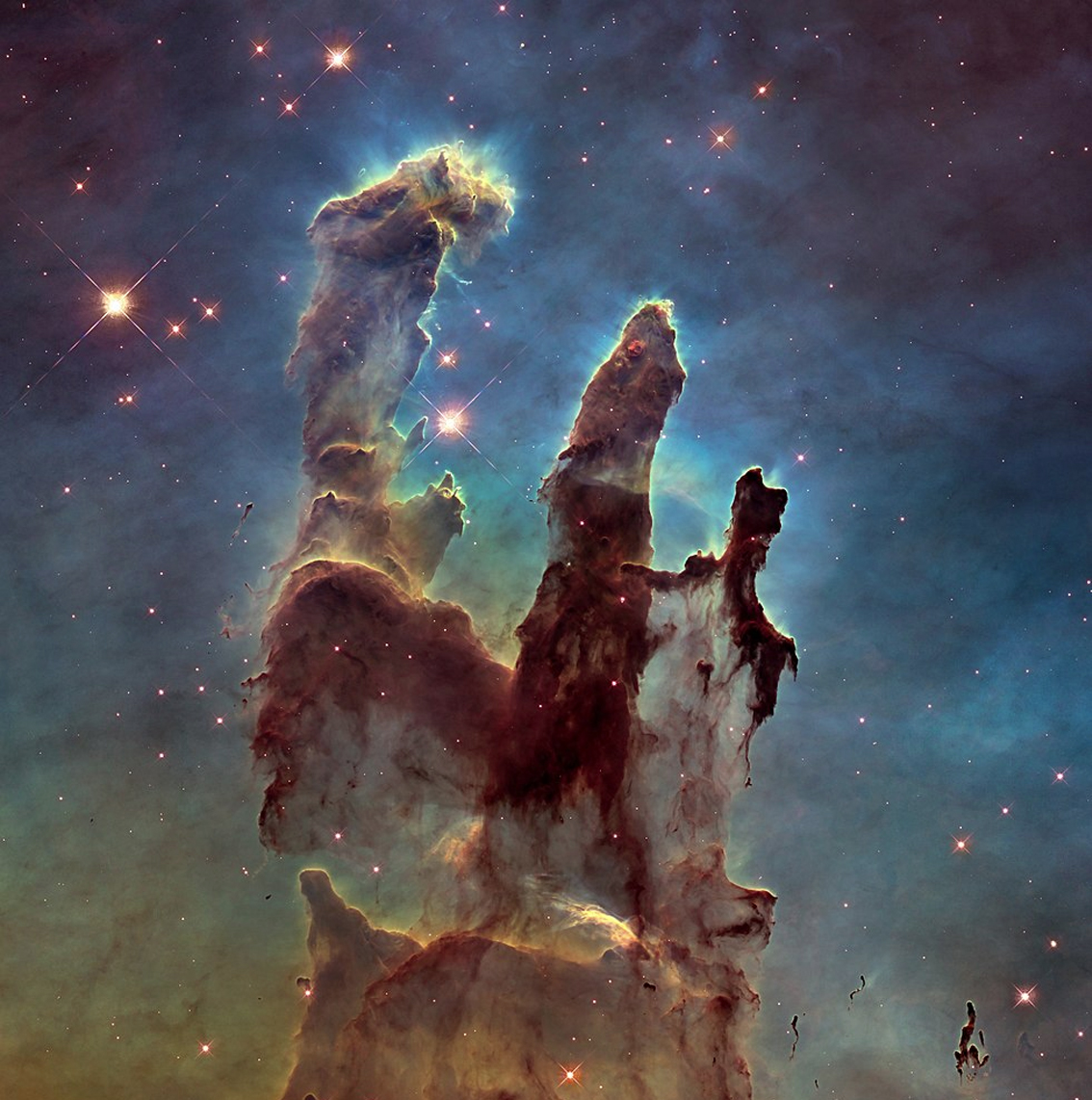
The Pillars of Creation, a nebula located 6,500 light years away. © NASA, ESA, and the Hubble Heritage Team (STScI/AURA)
Scroll through this diagram for a step-by-step explanation of stellar nucleosynthesis!




 What you need to remember about stars’ life cycle.
What you need to remember about stars’ life cycle.A star like the sun goes through these stages of development:
A collapsing nebula can form a small cloud into a star with a mass of between one and three times that of the sun.
1) Gravity causes the nebula to collapse, giving birth to a protostar.
2) The resulting protostar turns into a star similar to our sun. Nuclear reactions start taking place within the star’s core. This key stage in the star’s life, which is also by far the longest, is known as the ‘main sequence’. During this period, the star converts its hydrogen reserves into helium.
3) When the star has exhausted its stock of hydrogen, its main sequence ends and it turns into a red giant.
4) When all nuclear fusion stops, the red giant expels its outer layers into the space around it, becoming a planetary nebula.
5) The core of the planetary nebula then gradually cools, forming a white dwarf.

Life cycle of a medium-sized star, such as our Sun, and a massive star (© Arteclick).
How giant stars evolve :
A collapsing nebula can form a much larger cloud into a star with a mass of up to 10 times that of the sun.
1) Gravity causes the nebula to collapse, giving birth to a protostar.
2) The protostar is very large, very rich in gas and the temperature in its interior is extremely high. This protostar is on the way to becoming a blue giant. It consumes its immense reserves very quickly. It takes just 30 million years for the star’s fuel to run out, causing its nuclear reactions to cease.
3) The blue giant swells in size. As it gets bigger, its outer layers cool, giving the star a red colour. The star then becomes a red supergiant.
Next, the star’s nucleus collapses, causing a violent explosion that propels the star’s outer layers into space. This event is a supernova.
After this explosion, the star’s extremely dense nucleus becomes a neutron star.
If the star is very, very large, an exceedingly dense neutron star called a black hole may form. A black hole is an area of the universe where the force of gravity is so strong that not even light can escape from it.
 The various stages in the life of a star
The various stages in the life of a star

|

|

|
White dwarf |
Sun |
Red giant and supergiant |
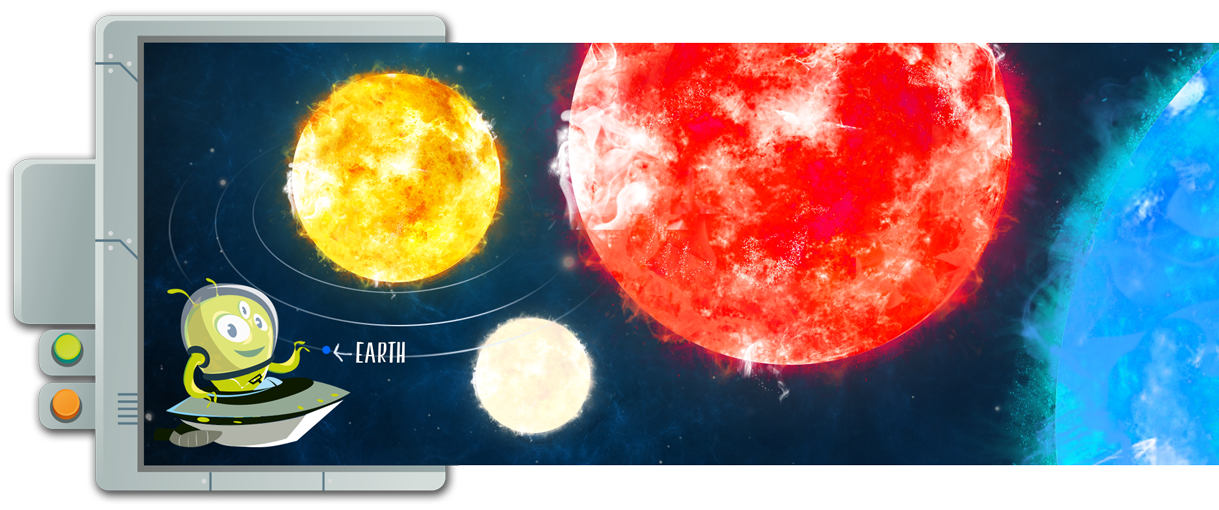
Blue giant |
Supernova |
Neutron star & black hole |

|

|

|
Quiz!
 Validate your knowledge!
Validate your knowledge!
Game
 The life cycle of stars: stellar nucleosynthesis
The life cycle of stars: stellar nucleosynthesisTest your knowledge by playing this little game!
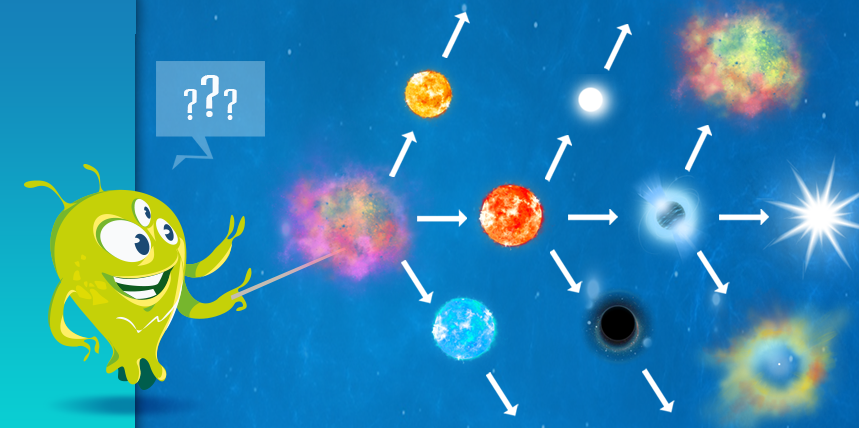
Back to menu
End of mission

Next adventure
We would like to thank :
Paul Denton
Denton Seismo Ltd UK,www.dentonseismo.co.uk
English translation
Serge Monnier
Aggregate of Philosophy
Proofreading
Sonja Bertschi
German translation
Romain Teyssier
University of Zürich, Switzerland
Advice, provision of digital simulations.
Philippe Labrot
IPGP, Institut de Physique du Globe de Paris, France
Scientific Interaction
Philippe Lognonné
IPGP, Institut de Physique du Globe de Paris, France
Scientific Interaction
Philippe Laudet
CNES, National Centre for Space Studies, France
Scientific Interaction
William Bruce Banerdt
JPL, Jet Propulsion Laboratory, Pasadena, CA, USA
Scientific Interaction
Credits : IPGP, NASA, JPL, CNES, CEA, ETH Zurich and University of Zürich